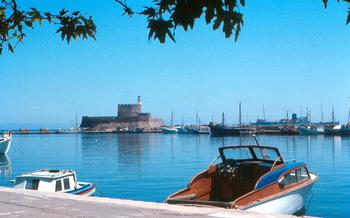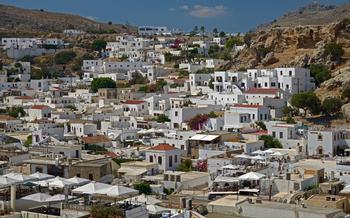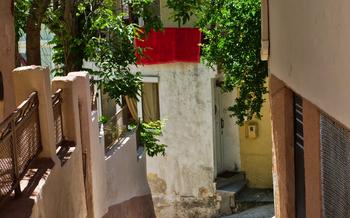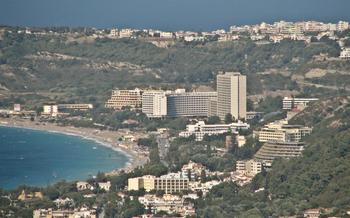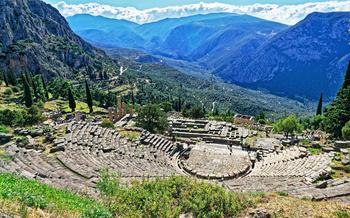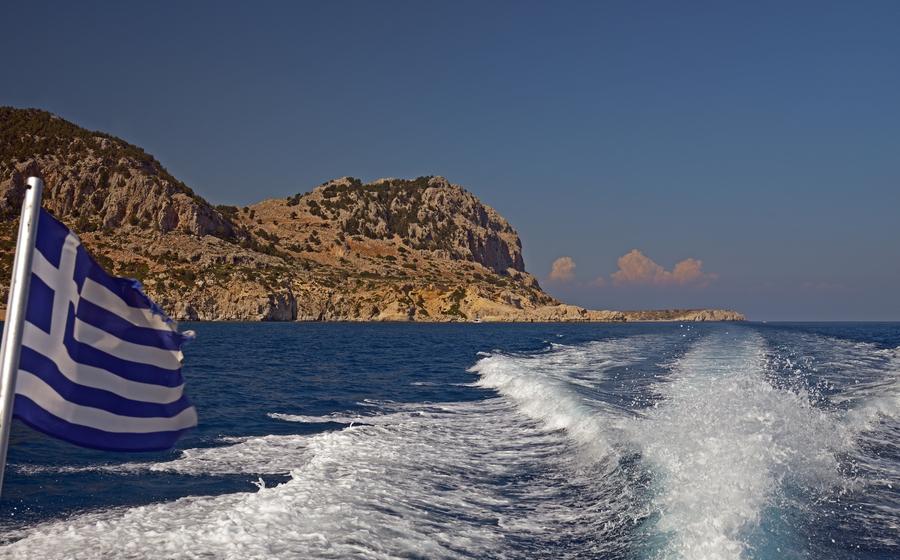
The Temple of Athena Polias and Zeus Polieus
- A Temple Built for Two Deities
- Location and History
- Architectural Marvel
- Sculptural Masterpieces
- Religious Significance
- Myths and Legends
- Excavations and Discoveries
- Restoration and Preservation
- Visiting the Temple
- Photography and Videography
- Nearby Attractions
- Local Cuisine and Hospitality
- Festivals and Events
- Sustainable Tourism
- Insider Tip: Unveiling Hidden Gems and Creating Unforgettable Memories
A Temple Built for Two Deities
In ancient Rhodes, the Temple of Athena Polias and Zeus Polieus stood as a testament to the city's deep religious beliefs and cultural identity. Dedicated to both Athena, the patron goddess of Rhodes, and Zeus, the supreme deity of the Greek pantheon, this remarkable structure embodied the essence of ancient Greek polytheism.
Athena, revered as the protector and guardian of Rhodes, was widely worshipped throughout the island. As the goddess of wisdom, war strategy, and crafts, she held a special place in the hearts of the Rhodians. Zeus, the king of the gods and ruler of Mount Olympus, was revered for his power, justice, and divine authority. By dedicating a temple to both deities, the Rhodians expressed their profound reverence and sought their blessings for the city's prosperity and protection.
The architectural design of the temple reflected its dual dedication. Separate entrances allowed worshippers to enter specific sections dedicated to each deity, while distinct altars stood within the temple, each dedicated to Athena or Zeus. This unique arrangement symbolized the individual significance of each god while emphasizing their shared presence within the sacred space.
Furthermore, the temple's interior featured exquisite representations of Athena and Zeus. Athena was often depicted as a majestic warrior goddess, clad in gleaming armor and wielding a spear and shield. Zeus, on the other hand, was portrayed as a powerful and authoritative figure, enthroned with thunderbolts in his hand, symbolizing his dominion over the heavens. These artistic representations brought the deities to life, allowing worshippers to feel a tangible connection with the divine.
Location and History
Perched atop the Acropolis of Lindos, the Temple of Athena Polias and Zeus Polieus commands a breathtaking panorama of the surrounding landscape, including the sparkling Aegean Sea, the verdant valleys, and the whitewashed village of Lindos nestled below. Constructed in the 3rd century BC, during the Hellenistic period, the temple has witnessed the rise and fall of civilizations, serving as a sanctuary for both the Rhodians and foreign visitors seeking divine favor.
In ancient times, the temple played a pivotal role in the religious life of the Rhodians. It was here that they gathered to honor Athena Polias, the patron goddess of Rhodes, and Zeus Polieus, the almighty king of the gods. The temple served as a venue for various religious ceremonies, festivals, and processions, bringing the community together in shared devotion and celebration.
Over the centuries, the temple has undergone numerous transformations, reflecting the changing political and cultural landscape of the region. In the 6th century AD, it was converted into a Christian basilica, bearing witness to the spread of Christianity throughout the Byzantine Empire. Despite its conversion, the temple retained its sacred significance, continuing to be a place of worship and pilgrimage.
In the 15th century, the Ottomans conquered Rhodes and the temple fell into disrepair. Its once-magnificent structure was gradually reduced to ruins, as its marble blocks were repurposed for other constructions. However, the temple's legacy endured, inspiring awe and curiosity among travelers and scholars who visited the site in the following centuries.
In the 20th century, archaeological excavations were conducted at the site, unearthing valuable insights into the temple's history and significance. These excavations revealed the temple's original foundations, architectural elements, and artifacts, shedding light on its construction techniques and religious practices. Today, the temple stands as a testament to the enduring power of faith and the resilience of the human spirit, inviting visitors to explore its rich history and marvel at its architectural grandeur.
Architectural Marvel
The Temple of Athena Polias and Zeus Polieus stands as a testament to the architectural prowess of ancient Greece. Constructed in the distinctive Doric style, the temple exudes simplicity, elegance, and harmonious proportions. Its sturdy columns, with their characteristic fluted shafts and unadorned capitals, support a massive entablature, creating a sense of strength and stability.
The temple's orientation is meticulously aligned with celestial events, demonstrating the sophisticated astronomical knowledge of the ancient Greeks. The east-facing entrance allows the first rays of the rising sun to illuminate the sacred interior, creating a dramatic effect that highlights the temple's religious significance.
The pediments, triangular gables above the colonnades, once adorned with exquisite sculptures, though now lost, would have further enhanced the temple's visual appeal. The metopes, rectangular panels between the triglyphs of the entablature, would have displayed intricate carvings depicting mythological scenes and deities, offering glimpses into the rich narratives of ancient Greek mythology.
The Temple of Athena Polias and Zeus Polieus ranks among the finest examples of Doric architecture in Greece. Its simple yet refined lines, coupled with its impressive scale and harmonious proportions, make it a must-see for anyone interested in ancient architecture and history.
Sculptural Masterpieces
The Temple of Athena Polias and Zeus Polieus is adorned with exquisite sculptures, showcasing the exceptional skills of ancient Greek artisans. The pediments, metopes, and friezes that once graced the temple depict a variety of mythological scenes and deities. These sculptures not only demonstrate the artistic prowess of the ancient Greeks but also offer insights into their beliefs and religious practices.
One of the most striking sculptures is the metope depicting the battle between Athena and the giants. Athena, the goddess of war and wisdom, is shown leading the charge against the monstrous giants, embodying her strength and determination. The intricate details of the sculpture, from the flowing drapery of Athena's garments to the fierce expressions on the giants' faces, bring the scene to life.
Another notable sculpture is the frieze depicting the procession of the gods. Zeus, the king of the gods, is shown leading the procession, followed by other deities such as Poseidon, Hera, and Apollo. Each god is depicted with their distinctive attributes, allowing viewers to identify them easily. The frieze highlights the importance of the temple as a center of religious worship and the reverence with which the gods were held.
Unfortunately, many of the sculptures that once adorned the temple have been lost or damaged over time. However, those that remain provide a glimpse into the artistic and religious traditions of ancient Greece and continue to captivate visitors to this day. Today, many of these sculptures are housed in museums around the world, where they can be admired and studied by scholars and art enthusiasts alike.
Religious Significance
The Temple of Athena Polias and Zeus Polieus held deep religious significance for the ancient Rhodians. It served as a central place of worship, where the people of Rhodes gathered to honor and pay homage to their patron deities. Within the temple's sacred walls, various rituals and ceremonies were performed, including sacrifices, offerings, and prayers. These rituals were believed to strengthen the bond between the gods and the people, ensuring divine protection and prosperity for the city.
The temple's religious significance extended beyond the local community. It was a symbol of the Rhodian's religious identity, representing their deep devotion to Athena and Zeus. Festivals and religious processions were held in honor of these deities, attracting pilgrims from across the island and beyond. The temple served as a focal point for these celebrations, uniting the people in a shared expression of faith and devotion.
Myths and Legends
The Temple of Athena Polias and Zeus Polieus is steeped in mythology and legend, adding to its allure and significance. According to one myth, the goddess Athena herself founded the temple after a contest with the sun god Helios. She struck the ground with her spear, and a spring of water gushed forth, creating a sacred spot where the temple was built.
Another legend tells of the miraculous intervention of Athena and Zeus during a siege of Rhodes by the Persians. The gods appeared in the sky, brandishing their weapons and terrifying the enemy, who fled in terror. From that day forward, the people of Rhodes believed that Athena and Zeus were their protectors, ensuring the temple's enduring importance as a symbol of divine favor.
Over the centuries, storytelling and oral traditions have kept these myths and legends alive, passing them down from generation to generation. Modern interpretations and reinterpretations continue to explore the symbolism and significance of these tales, providing a deeper understanding of the ancient Greek worldview and the enduring power of mythology.
Excavations and Discoveries
Archaeological excavations at the Temple of Athena Polias and Zeus Polieus have yielded a wealth of valuable artifacts and inscriptions, shedding light on the religious practices and history of the ancient Rhodians. Among the most significant discoveries are pottery fragments, coins, and other offerings, providing insights into the rituals and ceremonies performed within the temple. The unearthing of architectural elements, such as columns, capitals, and entablature blocks, has helped to reconstruct the temple's original appearance and understand its architectural design. Ongoing research and studies continue to contribute to our understanding of the temple's history, significance, and its role in the religious and cultural life of ancient Rhodes.
Restoration and Preservation
The Temple of Athena Polias and Zeus Polieus has undergone extensive restoration and preservation efforts to protect its remains from further deterioration and ensure its longevity. Conservationists face the delicate challenge of balancing the need to restore the temple to its former glory while maintaining its authenticity and historical integrity. Archaeologists, architects, and conservators collaborate closely to carefully assess the temple's condition, identify areas requiring intervention, and develop appropriate restoration techniques.
Restoration work involves cleaning and stabilizing the existing structure, repairing damaged elements, and reconstructing missing parts based on archaeological evidence. Conservators employ specialized techniques to conserve and protect the temple's original materials, such as stone, marble, and plaster. They use non-invasive methods to minimize the impact on the temple's fabric and ensure that any interventions are reversible.
Preservation measures include regular monitoring of the temple's condition, addressing any new threats or risks, and implementing preventive conservation strategies. The temple's surroundings are also carefully managed to ensure that environmental factors do not contribute to its deterioration.
By undertaking these restoration and preservation efforts, we not only preserve this iconic landmark for future generations but also safeguard a tangible link to our cultural heritage. The Temple of Athena Polias and Zeus Polieus stands as a testament to the enduring power of ancient Greek architecture and the ongoing commitment to protecting our shared cultural treasures.
Visiting the Temple
Planning a visit to the Temple of Athena Polias and Zeus Polieus is a rewarding experience that allows you to immerse yourself in ancient history and admire the architectural marvels of the past. The temple is open to visitors from Tuesday to Sunday, with varying hours depending on the season. Guided tours are available to provide in-depth insights into the temple's history, significance, and architectural features.
For a truly memorable experience, consider visiting the temple during the early morning or late afternoon hours when the soft, golden light beautifully illuminates the ruins and creates a serene atmosphere. If you have limited mobility or require special assistance, the site offers wheelchair accessibility and ramps to ensure an inclusive experience for all visitors.
To make the most of your visit, plan your itinerary to explore other attractions within the Acropolis of Lindos, such as the ancient theater, the Doric stoa, and the remains of the city walls. Combine your visit with a stroll through the picturesque village of Lindos, where you can admire the whitewashed houses, charming boutiques, and traditional tavernas.
Photography and Videography
At the Temple of Athena Polias and Zeus Polieus, capturing the grandeur and historical significance of the site through photography and videography is an unforgettable experience. Here are some guidelines and tips to ensure a respectful and rewarding visit:
-
Respect the Site's Significance: Remember that the temple is a place of historical and religious importance. Be mindful of your actions and avoid disturbing the tranquility of the site.
-
Capture the Best Angles: Explore different angles to capture the temple's majestic presence against the backdrop of the Aegean Sea. Experiment with wide shots to showcase the surrounding landscape and close-ups to highlight intricate details.
-
Consider Lighting Conditions: Plan your visit during the golden hour, around sunrise or sunset, to take advantage of the warm, diffused light that beautifully illuminates the temple's features.
-
Obtain Permission: For commercial photography or videography projects, obtaining permission from the relevant authorities is essential. Contact the local archaeological office or tourism board for guidance.
-
Share Responsibly: When sharing your images or videos on social media, accompany them with informative captions that highlight the temple's history and significance. Tag relevant cultural institutions or organizations to contribute to the promotion of this ancient treasure.
Nearby Attractions
Apart from the Temple of Athena Polias and Zeus Polieus, the Acropolis of Lindos boasts several other ancient sites and monuments that are worth exploring. The Acropolis, itself, is a remarkable archaeological site, offering breathtaking views of the surrounding landscape. Here, you can marvel at the well-preserved remains of the ancient city, including fortifications, temples, and public buildings.
Just a short walk from the Acropolis, you'll find the Ancient Theater of Lindos, a beautifully preserved amphitheater dating back to the 4th century BC. This theater once hosted theatrical performances, musical concerts, and other public events, and its acoustics remain impressive to this day.
Another must-see attraction is the Tomb of Kleoboulos, a monumental tomb dedicated to the famous 6th-century BC statesman and one of the Seven Sages of Greece. The tomb is an impressive example of ancient funerary architecture and offers insights into the burial customs of the ancient Greeks.
Beyond the Acropolis, the village of Lindos is a charming destination in its own right. With its whitewashed houses, cobblestone streets, and picturesque harbor, Lindos exudes a timeless beauty. Take some time to wander through its narrow alleys, browse the local shops, and soak up the laid-back atmosphere.
For a unique natural experience, consider a day trip to the Valley of the Butterflies, located just a short drive from Lindos. This lush valley is home to a remarkable variety of butterflies, creating a breathtaking spectacle during the summer months.
Another popular destination is the Seven Springs, a series of natural springs that form a cascading waterfall. The area surrounding the springs is ideal for swimming, picnicking, and enjoying the tranquil beauty of nature.
To make the most of your visit to Rhodes, consider crafting an itinerary that allows you to explore the Temple of Athena Polias and Zeus Polieus, as well as the other nearby attractions. Whether you're interested in history, archaeology, nature, or simply soaking up the local culture, Rhodes has something to offer every traveler.
Local Cuisine and Hospitality
Indulge in Culinary Delights and Experience Warm Hospitality
A visit to the Temple of Athena Polias and Zeus Polieus is not complete without savoring the flavors of Lindos. The village offers a tantalizing array of traditional dishes and delicacies that showcase the island's rich culinary heritage. From fresh seafood caught daily to mouthwatering meze platters bursting with local flavors, there's something to satisfy every palate.
For an authentic Greek dining experience, venture into the charming tavernas nestled along the cobblestone streets. These family-run establishments take pride in serving up centuries-old recipes passed down through generations. Be sure to try the succulent grilled octopus, fragrant moussaka, or hearty lamb stews, all prepared with fresh, locally sourced ingredients.
The people of Lindos are renowned for their warm hospitality and welcoming spirit. Engage in friendly conversations with the locals, who are always eager to share stories about their culture and traditions. Whether it's a simple exchange of greetings or an invitation to join a lively dance, embrace the opportunity to connect with the locals and experience the true essence of Greek hospitality.
When shopping for souvenirs, support local artisans and craftsmen who create unique handmade items inspired by the island's rich history and culture. From intricate ceramics and woven textiles to aromatic herbs and spices, there's a treasure trove of authentic souvenirs to take home as a reminder of your visit to Lindos.
Remember to observe local customs and etiquette when dining or visiting local establishments. Show respect for the Greek Orthodox religion and dress modestly when entering churches or monasteries. Tipping is customary in Greece, and a small gesture of appreciation for good service is always welcomed.
By embracing the local cuisine and immersing yourself in the warm hospitality of Lindos, you'll create lasting memories that go beyond the ancient ruins and into the heart of the island's vibrant culture.
Festivals and Events
The village of Lindos comes alive during its annual festivals and events, offering visitors a chance to immerse themselves in the local culture and traditions. The most significant event is the Lindos Festival, held in July or August, which showcases the island's rich heritage through traditional music, dance, and crafts. During the festival, the streets of Lindos are adorned with colorful decorations, and the atmosphere is filled with joy and celebration. Visitors can participate in workshops, demonstrations, and other cultural activities, gaining a deeper understanding of the island's unique customs and traditions. Planning a trip around these events is highly recommended for those seeking an authentic and vibrant experience of Rhodes.
Sustainable Tourism
As responsible travelers, we must prioritize the preservation of the Temple of Athena Polias and Zeus Polieus and its surroundings. Here are some tips for practicing sustainable tourism at the site:
-
Minimize Environmental Impact: Opt for public transportation or walking instead of driving to the temple. This reduces carbon emissions and helps protect the air quality in the area.
-
Support Local Businesses: Choose local restaurants, cafes, and shops that prioritize sustainability in their practices. This supports the local economy and encourages businesses to adopt environmentally friendly measures.
-
Be Mindful of Your Waste: Carry a reusable water bottle and avoid single-use plastics. Dispose of waste properly in designated bins to prevent littering and pollution.
-
Respect Local Traditions: Familiarize yourself with local customs and traditions to ensure respectful interactions with the community. Be mindful of noise levels and dress appropriately when visiting religious sites.
-
Promote Ethical Tourism: Share your experiences responsibly on social media, tagging relevant organizations and using hashtags related to sustainable travel. Encourage others to adopt similar practices, creating a positive impact on tourism in Rhodes.
Insider Tip: Unveiling Hidden Gems and Creating Unforgettable Memories
Beyond the well-trodden paths, the Temple of Athena Polias and Zeus Polieus holds secret spots that offer unique perspectives and experiences. One such gem is a secluded viewpoint nestled among ancient olive trees, revealing breathtaking panoramic vistas of the temple, the azure Mediterranean Sea, and the picturesque village of Lindos. For those seeking tranquility, venturing to the temple at sunrise or sunset offers moments of solitude and a chance to witness the magical play of light and shadow on the ancient ruins.
As a memento of your visit, consider exploring the local artisan workshops in Lindos, where you can find authentic souvenirs and handicrafts that capture the essence of the island's rich cultural heritage. Whether it's a hand-painted ceramic depicting ancient Greek motifs, a woven tapestry adorned with traditional patterns, or a delicate piece of jewelry inspired by the temple's architecture, these treasures will serve as lasting reminders of your journey.
To fully immerse yourself in the local culture, don't miss the opportunity to engage with the friendly locals, who are always eager to share stories and insights about the temple and their beloved island. Whether it's striking up a conversation at a traditional taverna or joining a cooking class to learn the secrets of Rhodian cuisine, these interactions will create lasting memories and a deeper connection to the spirit of Rhodes.

